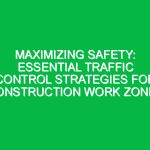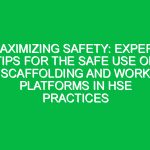Construction sites are inherently risky environments. With heavy machinery, elevated work areas, and the constant movement of materials, the potential for accidents is always present. Recognizing this, the Health Safety and Environment (HSE) domain emphasizes the importance of preparedness, particularly in the form of first aid and medical facilities on-site. This guide delves into the essentials of equipping construction sites with the necessary medical provisions to enhance HSE compliance and ensure worker safety.
Understanding the Importance of First Aid and Medical Facilities in Construction
Before diving into the specifics, it’s crucial to understand why first aid and medical facilities are non-negotiable on construction sites. In the event of an accident, immediate medical attention can significantly reduce the severity of injuries, and in some cases, save lives. Moreover, having these facilities on-site is not just about responding to accidents; it’s about creating a safety-conscious culture that values the well-being of every worker.
The Role of First Aid in Construction Safety
First aid serves as the first line of defense following an accident. It involves the initial care provided to an injured person until professional medical help arrives. In the construction context, first aid can range from cleaning minor cuts to performing CPR. The availability of a well-stocked first aid kit and trained personnel can make a substantial difference in the outcome of construction site accidents.
Why Medical Facilities Matter
While first aid is crucial, some situations require more comprehensive medical intervention. This is where on-site medical facilities or access to nearby medical services becomes vital. These facilities can offer advanced care, such as wound suturing, fracture stabilization, and emergency medication administration, thereby bridging the gap until the injured can be transported to a hospital if necessary.
Key Components of Effective Construction Site Medical Facilities
To truly enhance HSE compliance and worker safety, construction sites must have certain key components in place regarding first aid and medical facilities.
Well-Stocked First Aid Kits
First aid kits on construction sites should be tailored to the specific risks present. This means going beyond the basics to include items like tourniquets, splints, and burn dressings. Regular audits should be conducted to ensure these kits are fully stocked and that all items are within their expiry dates.
Trained First Aid Personnel
Having first aid kits is one thing; having personnel trained to use them is another. Construction sites should have a sufficient number of workers trained in first aid, including CPR and the use of automated external defibrillators (AEDs), to ensure that immediate care is always available.
Accessible Medical Facilities
For more severe injuries, easy access to medical facilities is essential. This could mean having an on-site clinic for larger projects or ensuring there is a clear plan for quickly transporting injured workers to nearby hospitals or medical centers for smaller sites.
Emergency Response Plans
Effective emergency response plans are a cornerstone of construction site safety. These plans should detail the steps to be taken in the event of various types of emergencies, including who to contact, how to evacuate the site if necessary, and how to provide immediate care while waiting for professional medical assistance.
Enhancing HSE Compliance Through Training and Awareness
Compliance with HSE standards is not just about having the right facilities and equipment; it’s also about ensuring that all workers are aware of and understand how to use these resources. Regular training sessions, drills, and awareness campaigns can help foster a culture of safety that prioritizes the health and well-being of every individual on the construction site.
Regular First Aid Training
First aid training should not be a one-time event. Regular refresher courses are essential to keep skills sharp and ensure that all personnel are up-to-date with the latest first aid techniques and protocols.
Safety Drills and Simulations
Conducting regular safety drills and simulations can help prepare workers for real-life emergencies. These drills should cover a range of scenarios, from minor injuries to major incidents, to ensure a well-rounded preparedness.
Awareness Campaigns
Continuous awareness campaigns can reinforce the importance of safety and the availability of first aid and medical facilities. These campaigns can also highlight recent changes or updates to emergency response plans and encourage a proactive approach to safety.
Conclusion: A Summary of Key Points
Construction sites are dynamic environments where the risk of accidents is ever-present. Enhancing HSE compliance and worker safety requires a multifaceted approach that includes the provision of well-stocked first aid kits, trained first aid personnel, accessible medical facilities, and comprehensive emergency response plans. Beyond the physical provisions, fostering a culture of safety through regular training, drills, and awareness campaigns is crucial. By prioritizing the health and well-being of workers, construction sites can not only comply with HSE standards but also create a safer, more productive working environment.
Remember, safety is not just a regulation; it’s a responsibility. Ensuring that every construction site is equipped with the necessary first aid and medical facilities is a critical step in fulfilling this responsibility and safeguarding the lives and well-being of workers.


